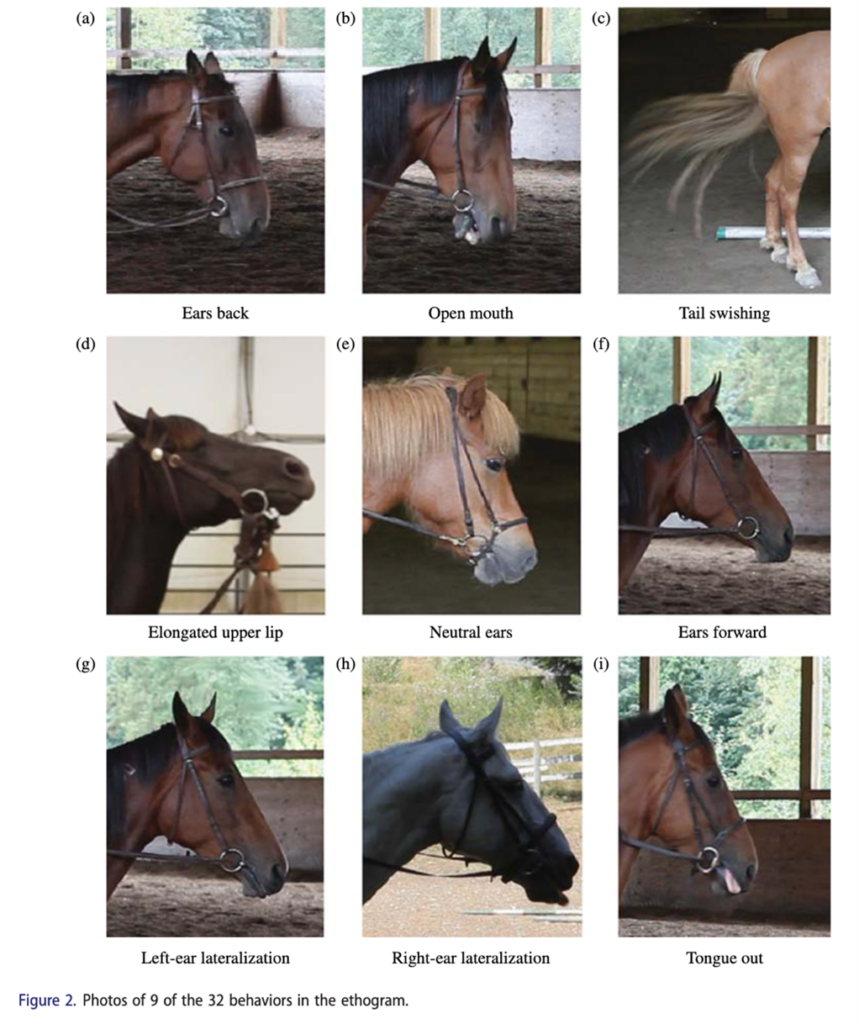Behavioural indicators of stress, pain & discomfort
Horses are prey animals that are evolutionarily tuned to be constantly alert for the presence of predators.
If a horse experiences stress or fear they have 4 behavioural responses and they may do one, two or exhibit a combination of responses:
- Flight – fleeing from danger is the horses preferred option to remove themselves from danger, whether the danger is real or otherwise. An example of this would be bolting.
- Freeze – where a horse can’t flee a situation they may plant their feet and stand almost motionless. An example of this may be the handler is trying to lead a horse into a trailer and the horse is fearful.
- Fidget – horses may also fidget. This is known as a displacement behaviour where the animal is conflicted about what to do and so fidgets on the spot. An example of this would be when out hacking and the horse sees a shadow that produces a fearful response but the rider is using a forward aid to prevent the freeze response and rein pressure to prevent a flight response so the horse fidget on the spot.
- Fight – a horse that is cornered or has learnt that an aggressive response works may show a fight response. Usually a horse will only show this response when it has tried the above 3 or is not able to show the above 3 responses. An example of this would be a horse that is fearful of the handler kicking out when the handler goes to put a headcollar on in the stable.
Remember in the previous learning we considered the horses mood and how we can use descriptions to try and determine their affective state? We can use a different set of descriptions to identify a horse that may be in discomfort or pain:
Posture and weight bearing
- Non-physiological locomotion
- Shifting weight/resting limb
- Pointing a limb
- Prolonged resting of a limb
- Cross legged resting of a limb
- Camping under
- Dragging a limb
- Dangling a limb
- Base narrow or base wide
- Low head carriage
- Tucked up abdomen
- Leaning against objects
- Atypical recumbancy
- Difficulty rising
- Urination posture and effort without stream
- Parking out
- Straining to defeacate
- Stepping on the spot
- Lifting/holding limb up
- Pawing
- Stomping
- Kicking out or back
- Kicking up towards abdomen
- Romping/bucking
- Rolling
- Backing tentatively
- Limb trembling
- Flinching
- Stretching (head high, deep abdominal, hindlimb extension, neck curl
Head, neck, mouth and lip movements
- Rotational head or whole body shaking
- Frustration head tossing
- Head nodding
- Nose tossing/flipping
- Abbreviated weaving
- Sympathetic surge resolution signs – extending tongue, licking, chewing, itching
- Frequent yawning
- Spontaneous flehmen
- Lip quivering/wincing
- Tilting head
- Looking at an area
- Swatting
- Autogrooming
Ear and tail movements
- Moving/focusing ears caudally
- Swishing/flicking tail
- Slapping tail against perineum
- Lifting/holding tail of perineum
Overall demeanour
- Dull expression
- Dull demeanour
- Guarding
- Conservative movement
- Uncharacteristic aggression
- Hyper-responsive/startle prone
- Restlessness (changing activities frequently, circling, pacing, abdominal recumbency or elimination attempt, frequent repositioning during recumbency, nibbling aimlessly, fidgeting, intense distance staring)
Altered eating or drinking
- Sipping water
- Quidding
- Atypical jaw motion
- Disinterest in food/water
Vocalisations
- Sighing, snorting, whining, groaning, grunting, squealing, screaming, calling, teeth grinding

Signs of stress in horses
Tail
- Swishing
- Clamped over anus
- Raised tail
- Higher muscle ton
Ears
- Back
- Rapid movement
- Rigid and pointing towards fearful stimulus
Head position
- Held above the withers
- Rapid upward movement
- Static focused attention on a fearful stimulus
Mouth
- Tense lips
- Teeth visible
- Nostril flare
Head
- Rapid shaking
- Rapid or sharp movements
Movement
- Fidgeting
- Rapid foot movement on the spot
- Jerky movements
Eyes
- Visible sclera (whites of eyes)
- Tense ocular muscles (wide eyed)
Signs of relaxation in horses
- Closed mouth
- Elongated upper lip
- Head below withers
- Head in neutral position
- Head level with withers
- Ear soft
- Ears facing different directions or relaxed and outwards
- Yawning
- Licking/chewing